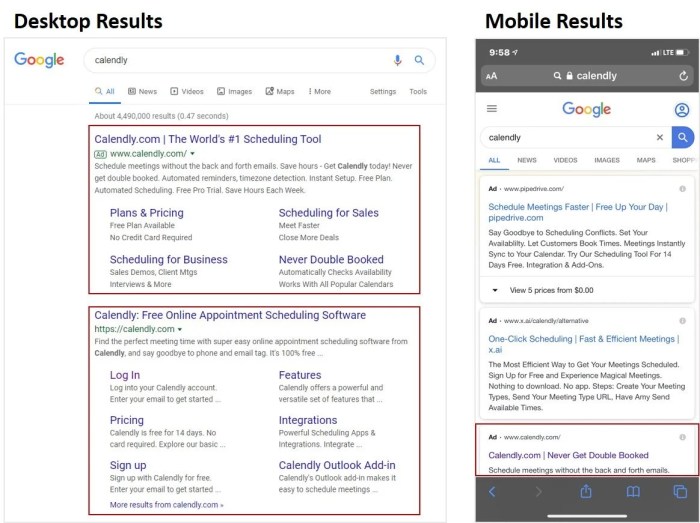Why you should bid on your brand name and when you shouldnt – Why you should bid on your brand name and when you shouldn’t is a crucial aspect of online advertising strategy. Understanding the nuances of brand name bidding is key to maximizing your ROI and avoiding costly mistakes. This exploration dives into the benefits of securing top positions for your brand in search results, while also highlighting situations where this approach might be detrimental.
From defining brand name bidding strategies and exploring various platforms, to analyzing competitor tactics and optimizing for different search engines, we’ll unpack the complexities of this vital marketing technique. We’ll also uncover the critical moments when you should
-not* bid on your brand name to prevent wasted ad spend and potential reputational damage. The key is knowing when to bid and when to steer clear.
Defining Brand Name Bidding
Bidding on your brand name in online advertising is a crucial strategy for protecting your brand’s reputation and ensuring customers land onyour* website when they search for your products or services. It’s not just about visibility; it’s about control. By securing the top spots in search results for your brand name, you maintain a consistent online presence and can drive targeted traffic to your site.Brand name bidding is the practice of paying to have your website appear prominently in search results when a user types in your brand name or variations of it.
This is done to ensure that your website is the first thing customers see when they search for your company. It’s essentially a way to own the online conversation about your brand.
Brand Name Bidding Strategies
Different bidding strategies cater to different needs. Understanding the options is crucial for maximizing your return on investment.
- Exact Match Bidding: This strategy ensures your ads show only when a user’s search query is an exact match for your brand name. This is a highly targeted approach. It’s often the best strategy for preventing competitors from appearing in top positions when someone searches for your brand name. For instance, if your brand is “Acme Widgets,” an exact match campaign will only display your ads when someone types “Acme Widgets.” This minimizes wasted ad spend and maximizes relevance.
- Phrase Match Bidding: This approach goes a step further by including variations of your brand name in the search query. For example, “Acme Widgets” would trigger ads for searches like “best Acme Widgets,” or “cheap Acme widgets.” This broadens your reach while maintaining a high level of relevance.
- Broad Match Bidding: This is the broadest approach, showing your ads for a wider range of searches related to your brand name. This could include “widget maker” or “cheap widgets.” While potentially reaching a larger audience, it also exposes you to a higher chance of irrelevant clicks and reduced ROI if not carefully managed.
Platforms for Brand Name Bidding
Brand name bidding isn’t limited to search engines. Various online platforms allow you to strategically position your brand.
- Search Engines (e.g., Google, Bing): Search engines are the primary platform for brand name bidding. Here, you use bidding to secure prominent positions for your brand name. A successful campaign on these platforms requires a deep understanding of search query patterns and audience behavior.
- Social Media Platforms (e.g., Facebook, Instagram, Twitter): Social media platforms can also be integrated into your brand name bidding strategy. You can use relevant hashtags and paid advertising to ensure your brand is prominently displayed in social media feeds and search results related to your brand name.
Essential Elements of a Successful Brand Name Bidding Strategy
A successful brand name bidding strategy relies on several key components.
- Thorough Research: Identify all possible variations of your brand name, including misspellings, abbreviations, and related terms. This is crucial to capture the full spectrum of potential searches related to your brand.
- Competitive Analysis: Analyze your competitors’ bidding strategies and ad copy. Understanding their tactics will allow you to refine your strategy and stay ahead of the curve.
- Budget Optimization: Allocate your budget effectively across different bidding strategies. Continuously monitor performance and adjust bids as needed to maximize return on investment.
- Performance Tracking and Reporting: Regularly track key metrics such as click-through rates (CTR), cost-per-click (CPC), and conversion rates. This data provides insights into the effectiveness of your campaign and allows for necessary adjustments.
Benefits of Bidding on Your Brand Name

Securing top positions for your brand name in search results is a powerful strategy that can significantly boost your online presence and profitability. It’s about more than just visibility; it’s about establishing trust, authority, and ultimately, driving more customers to your business. This approach leverages the immense power of search engine optimization () and paid advertising to achieve concrete results.Brand name bidding, when strategically implemented, becomes a crucial component of your overall marketing plan.
It allows you to control how your brand is perceived online, ensuring your message reaches potential customers directly, and builds a powerful association between your brand and the relevant s. This approach, when done correctly, can significantly enhance your bottom line.
Dominating Search Results
Top positions in search results for your brand name translate to immediate visibility. Potential customers actively searching for your brand will instantly encounter your website or landing page, boosting brand awareness and fostering a strong initial impression. This visibility is crucial, especially in competitive markets, where securing a top position can be a significant differentiator.
Enhancing Brand Visibility and Recognition
Consistent presence at the top of search results reinforces your brand identity and strengthens brand recognition. Potential customers who repeatedly see your brand name in prominent positions will associate your company with quality, reliability, and industry leadership. This consistent exposure cultivates a strong brand presence in the minds of your target audience, increasing brand recall and driving familiarity.
Bidding on your brand name is crucial for maintaining control over your online presence, but there are times when it’s not the best strategy. For example, if your brand name is highly competitive, it might be more cost-effective to focus on other keywords. This week’s search updates, as detailed in this week in search unlikely pairing new updates , show how search algorithms are constantly evolving.
Ultimately, the decision of whether or not to bid on your brand name hinges on careful keyword research and understanding your target audience.
Building Customer Trust and Loyalty
By proactively managing your brand name in search results, you cultivate trust and loyalty. When customers find your business at the top of their search, it signals reliability and trustworthiness. This positive initial experience is pivotal in fostering long-term customer relationships. Potential customers are more likely to engage with a brand they trust, leading to increased customer loyalty and repeat business.
Establishing Industry Authority
Positioning your brand at the top of search results for your brand name positions you as an industry authority. It signifies your prominence and expertise in the field. This establishes credibility and trust, which are critical elements in establishing your brand as a leader. Potential customers are more likely to consider you a trusted source of information and products or services in your industry.
Successful Brand Name Bidding Examples
Numerous companies have leveraged brand name bidding to achieve substantial gains. For instance, a large retailer, consistently ranked at the top of search results for their brand name, saw a significant increase in online sales. Another example is a tech company that leveraged this strategy to capture a larger market share in their niche. These real-world examples demonstrate the tangible benefits of brand name bidding in enhancing brand visibility and market share.
When NOT to Bid on Your Brand Name
Bidding on your brand name in online advertising can be a powerful strategy, but it’s not a universal solution. There are specific circumstances where it might be detrimental to your marketing efforts and even harmful to your brand image. Understanding these situations is crucial to avoid wasting valuable advertising budget and potential customer goodwill.
A brand name bid strategy isn’t always the best approach. Consider your specific business needs and competitive landscape before committing to this method. Sometimes, alternative advertising methods might prove more effective and cost-efficient, leading to better ROI and stronger customer engagement.
Situations Where Brand Name Bidding is Counterproductive
Brand name bidding, while tempting, can be a poor strategy in several scenarios. It’s crucial to weigh the potential benefits against the potential downsides to make informed decisions.
- When your brand name is highly generic or easily confused with other brands.
- When you have a limited budget.
- When your brand awareness is extremely low.
- When competitor bidding on your brand name creates negative customer perception.
High Competition and Generic Brand Names
If your brand name is similar to a competitor’s or if it’s a common term in your industry, bidding on it might lead to wasted ad spend. High competition for your brand name s will drive up the cost per click (CPC), potentially making it unprofitable. Consider if alternative s or strategies would yield better results.
- A clothing brand named “Threads” would face intense competition with other brands using similar s. Bidding on “threads” could be very expensive and yield a low return on investment.
- A real estate agency named “Homes” would likely encounter the same challenge, as “homes” is a very generic term.
Limited Budget and Low Brand Awareness
Bidding on your brand name requires a substantial budget, particularly in competitive markets. If your brand is relatively unknown, the initial investment required to secure visibility might outweigh the return. A smaller business with a restricted budget should focus on targeted advertising to reach a smaller, but more qualified audience.
- A startup with limited capital should focus on social media advertising or content marketing to build brand awareness before engaging in costly brand name bidding campaigns.
Negative Customer Perception from Competitor Bidding
If competitors bid on your brand name, it can lead to confusion and frustration for consumers. This is especially true if the competitor’s ads are misleading or provide inferior products or services. Consumers might view your brand negatively due to the association with the competitor’s actions.
Comparison to Other Advertising Strategies
Alternative advertising strategies can offer a more cost-effective approach to achieve similar results. Consider the following strategies:
- Targeted Advertising: Focusing on relevant s rather than your brand name can significantly reduce costs and improve conversion rates.
- Social Media Marketing: Building a strong social media presence can generate organic traffic and brand awareness at a lower cost than brand name bidding.
- Content Marketing: Creating valuable content (blog posts, articles, videos) that resonates with your target audience can attract organic traffic and establish thought leadership.
Analyzing Competitor Brand Name Bidding Strategies: Why You Should Bid On Your Brand Name And When You Shouldnt
Understanding how competitors are using brand name bidding is crucial for developing a robust online strategy. It’s not just about reacting to their tactics; it’s about proactively shaping your own approach and mitigating potential damage to your brand. This analysis provides a framework for understanding competitor behavior, enabling you to adapt and improve your own brand name bidding campaigns.Competitor brand name bidding is a dynamic landscape, constantly evolving with new strategies and tactics.
Recognizing the patterns and intentions behind these bids is vital for successful brand protection and optimization of your own search presence. By analyzing competitor strategies, you can identify potential weaknesses and opportunities to improve your own performance.
Competitor Strategies Comparison
A deeper understanding of competitor strategies requires comparing their approaches. This comparison highlights similarities and differences in their bidding tactics.
| Competitor | Bidding Strategy | Targeting | Budget Allocation |
|---|---|---|---|
| Company A | Aggressive, high bids on all relevant s, including variations of brand name. | Broad, targeting a wide range of users, especially those with high purchase intent. | Significant, allocating a large portion of budget to brand name bidding. |
| Company B | Defensive, primarily focusing on bidding on negative s related to their brand name. | Narrow, targeting users who are less likely to be interested in their products. | Moderate, allocating budget to protect against competitor brand name bidding. |
| Company C | Proactive, using brand name bidding to drive awareness and brand recognition. | Broad, targeting a wide range of users, especially those searching for general information related to their products. | Balanced, allocating budget to both brand name and other relevant s. |
Metrics for Monitoring Competitor Activity
Monitoring competitor brand name bidding requires tracking key performance indicators (KPIs). These metrics provide insights into their strategies and potential impact on your brand.
- Click-Through Rate (CTR): Examining the CTR on competitor brand name ads helps understand the effectiveness of their campaigns in attracting clicks. High CTRs indicate strong ad copy or relevance to user searches.
- Cost-Per-Click (CPC): Analyzing CPCs reveals the amount competitors are paying for clicks on their brand name ads. High CPCs might signal aggressive bidding strategies.
- Search Ranking Positions: Tracking competitor positions in search results gives a clear picture of their overall search engine optimization () performance.
- Bidding Data: Accessing competitor bidding data, if available, reveals which s they’re bidding on and how aggressively. This can reveal their target audience and product offerings.
Impact of Competitor Bidding on Search Ranking
Competitor brand name bidding can significantly influence your search ranking. This impact varies depending on factors such as bidding strategies and your own efforts.
| Competitor Bidding Strategy | Impact on Your Brand Ranking |
|---|---|
| Aggressive Bidding | Potentially lower ranking for your brand name; difficulty appearing in top search results. |
| Defensive Bidding | Minimal impact on your brand ranking, but may affect visibility for specific s. |
| Proactive Bidding | Potential for your brand name to be less visible in search results due to higher competition. |
Examples of Negative Brand Name Bidding
Competitors might employ negative brand name bidding strategies to harm your brand image or drive traffic to their own sites.
- Misleading Ads: Creating misleading or inaccurate ads related to your brand to attract clicks.
- Negative Reviews: Promoting negative reviews or feedback on your brand name to influence consumer perceptions.
- Malicious s: Bidding on negative s related to your brand to limit your visibility.
Risks and Opportunities, Why you should bid on your brand name and when you shouldnt
Understanding competitor strategies presents both risks and opportunities. Careful monitoring and strategic responses are essential.
- Risks: Loss of visibility in search results, damage to brand reputation, increased advertising costs.
- Opportunities: Identification of competitor weaknesses, development of counter strategies, potential to attract customers by showcasing your brand’s advantages.
Strategies for Managing Brand Name Bids

Mastering brand name bidding requires a strategic approach beyond simply setting a bid. Effective management involves adapting to platform nuances, monitoring performance, and aligning bidding strategies with overall marketing goals. This is crucial for maximizing ROI and protecting your brand’s online presence.Successful brand name bidding isn’t just about the initial bid; it’s a dynamic process that requires ongoing refinement.
Bidding on your brand name domain can be a smart move, but it’s not always the best option. It’s crucial to understand your brand’s visibility and target audience. For example, if your brand is already well-established and consistently generating a significant online presence, it might be worthwhile. However, if you’re a startup with limited reach, it could be a waste of resources.
Fortunately, there’s a wealth of insights on onboarding digital marketing talent from agency leaders, offering crucial perspectives on talent acquisition and development. This information is essential for making strategic decisions regarding brand name bidding and ensures you are making the right call for your specific situation. Learning how to onboard digital marketing talent, as discussed in this excellent article on how to onboard digital marketing talent according to agency leaders , can help you avoid unnecessary expenses.
Ultimately, careful consideration of your brand’s stage and goals is key to making the right bidding decision.
You need a robust system to track performance and make informed adjustments to stay ahead of competitors and maintain a strong online position.
Different Approaches for Managing Brand Name Bids Across Various Platforms
Various online advertising platforms have unique characteristics. Understanding these differences is vital for crafting effective strategies. For example, Google Ads demands a different approach than social media platforms like Facebook or Instagram. Platforms like Bing Ads or DuckDuckGo Ads might require different targeting strategies. Each platform’s algorithm and user behavior influence how you manage your brand name bids.
Best Practices for Managing Brand Name Bids
| Platform | Best Practice |
|---|---|
| Google Ads | Utilize broad match s alongside phrase match and exact match for your brand name to capture variations in search queries. Consider negative s to exclude irrelevant searches. |
| Bing Ads | Implement a similar strategy to Google Ads, focusing on variations of your brand name and competitor names. Monitor for discrepancies in click-through rates (CTRs) and quality scores to adjust bids accordingly. |
| Social Media (Facebook, Instagram) | Target your brand name bids with specific demographics and interests to ensure your ads reach the most relevant audience. Use retargeting campaigns to re-engage users who have interacted with your brand. |
| Other Search Engines | Research search volume and competition on the specific platform. Experiment with different bidding strategies to see what works best for your brand. |
Monitoring and Adjusting Brand Name Bids Based on Performance Data
Regularly monitoring key performance indicators (KPIs) is critical. Track metrics like click-through rates (CTR), cost-per-click (CPC), conversion rates, and return on ad spend (ROAS). Analyze this data to identify trends and areas for improvement. If your CTR is low, consider refining your ad copy or s. High CPCs might signal a need to adjust bids downward or target a more specific audience.
Implementing Brand Name Bidding Within a Larger Marketing Campaign Strategy
Brand name bidding should be integrated into a comprehensive marketing plan. It shouldn’t exist in a silo. Align your brand name bidding strategy with your overall marketing objectives, such as driving website traffic, generating leads, or increasing sales. For instance, if your goal is lead generation, focus on landing pages designed for lead capture within your ad copy.
Bidding on your brand name in domain searches can be a smart move, boosting your online presence and driving traffic directly to your site. However, if your brand name is already taken, or if you’re a new business with a very niche market, it might not be worth the hefty price tag. To ensure you’re choosing the right SEO agency to help you navigate these decisions, check out these 8 helpful tips in this fantastic infographic: 8 tips to choose the right seo agency with infographic.
Ultimately, understanding your market and your budget will guide you towards the most effective and affordable strategy for securing your brand online.
Examples of Successful Brand Name Bidding Campaigns
One successful campaign used a combination of broad match and phrase match s for their brand name on Google Ads, achieving a 10% increase in website traffic within a month. They also tracked their competitors’ bidding strategies to adjust their own bids proactively. Another example involved a company that saw a 15% improvement in conversion rates after refining their social media brand name bidding strategy, targeting specific demographics and interests more precisely.
Data from these campaigns highlighted the importance of consistent monitoring and adjustment based on performance metrics.
Optimizing Brand Name Bidding for Different Search Engines/Platforms
Brand name bidding is a crucial aspect of online marketing, especially for businesses aiming to maximize visibility and control their brand’s online presence. However, the strategies for effectively bidding on your brand name vary significantly across different search engines and platforms. Understanding these nuances is key to achieving optimal results.Effective brand name bidding requires a nuanced approach, adapting to the unique characteristics of each platform.
This involves considering factors like search algorithms, user behavior, and platform-specific features. By understanding these elements, businesses can craft targeted strategies that enhance their brand visibility and drive conversions.
Brand Name Bidding Strategies Across Search Engines
Different search engines employ distinct algorithms for determining ad placement and relevance. Understanding these differences is critical for crafting effective brand name bidding strategies. Google, for instance, prioritizes user intent and relevance, while Bing emphasizes a broader range of factors, including historical search patterns.
- Google: Google’s algorithm prioritizes relevance and user intent. Bidding strategies should focus on precise s and landing pages optimized for specific user searches. Negative s are crucial to avoid wasting budget on irrelevant clicks. Google Ads offers tools to refine targeting and monitor campaign performance, enabling adaptation to algorithm changes.
- Bing: Bing’s algorithm often emphasizes broader search queries. Bidding strategies may require more flexibility and testing to determine optimal bids across various search terms. A comprehensive approach to research and campaign management is necessary.
Brand Name Bidding on Social Media Platforms
Social media platforms present unique opportunities for brand name bidding, leveraging social engagement and targeted advertising. Understanding these nuances allows for a tailored strategy to achieve optimal results.
- Facebook: Facebook’s targeting options are incredibly granular, enabling precise targeting based on demographics, interests, and behaviors. Bidding strategies should align with Facebook’s algorithm, prioritizing high-quality ads and engaging content.
- Instagram: Instagram’s algorithm is closely tied to Facebook’s, but visual appeal and engagement play a significant role. Bidding strategies must prioritize visually compelling ads and encourage interaction with the brand.
- Twitter: Twitter’s algorithm prioritizes real-time trends and engagement. Brand name bidding strategies on Twitter should focus on relevant hashtags, timely updates, and interaction with followers.
Optimal Bidding Strategies Table
The following table summarizes optimal brand name bidding strategies across different platforms:
| Platform | Bidding Strategy Focus | Key Considerations |
|---|---|---|
| Relevance, precision, negative s | User intent, landing page optimization | |
| Bing | Broader search queries, flexibility | Historical search patterns, comprehensive research |
| Granular targeting, high-quality ads | Demographics, interests, behaviors | |
| Visual appeal, engagement | Visually compelling ads, interaction | |
| Real-time trends, engagement | Relevant hashtags, timely updates |
Adapting to Platform Algorithms
The success of brand name bidding relies heavily on adapting to the constantly evolving algorithms of each platform. Continuous monitoring, testing, and adjustments are crucial for maintaining optimal performance. Regular analysis of campaign data, coupled with understanding algorithm updates, ensures alignment with the platform’s current criteria.
Platform-Specific Requirements Table
The following table Artikels the specific requirements for brand name bidding on various platforms:
| Platform | Specific Requirements |
|---|---|
| Google Ads | Ad copy, landing pages, research |
| Bing Ads | Campaign structure, ad copy, bidding strategy |
| Facebook Ads | Audience targeting, ad creative, budget |
| Instagram Ads | Visual appeal, ad format, targeting |
| Twitter Ads | Relevant hashtags, engagement, campaign objectives |
Closure
In conclusion, strategic brand name bidding can significantly boost your brand visibility and customer loyalty. However, it’s not a one-size-fits-all solution. By understanding the potential benefits, the pitfalls, and how to effectively manage competitor strategies, you can make informed decisions about your brand name bidding. Ultimately, a calculated approach, understanding your specific market, and meticulous monitoring are vital for successful brand name bidding campaigns.






